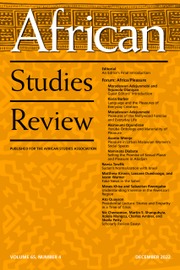Stephanie Starling engaged in extensive interviews and discussions with thirty Tswana women about their understanding of what womanhood means to them, and how they experience their current situation. She drew on contacts she had made over several years of residence and work in Botswana to reach women who consented to discuss the details of their personal lives. The results are both informative and discouraging and corroborate similar reports about women’s lives around the world. Starling frequently compares her findings with Isaac Schapera’s early work in Botswana to demonstrate the continuing restrictions on women (A Handbook of Tswana Law and Custom [LIT Verlag, 1938], and Married Life in an African Tribe [Penguin, 1940]).
The book begins with an epigraph that sets a major theme of the book: “That’s how it is here. Men do what they want” (1). Two introductory chapters give a brief overview and discuss the theoretical and methodological context of her research. She then analyzes the idea of “womanhood,” and how her interlocutors understand the expectations of adult women’s lives. Marriage emerges as the central probability for all women, with pressure from close family members and society at large to marry and remain married, with the accompanying goal of having children. Not all of her respondents were married, and at least a couple of them expected to remain unmarried while pursuing their careers, but all had experienced comments and criticisms about their marital status.
Much of the rest of the book details how the limited view of women’s lives has meant real restrictions for women who for the most part lived in the capital, Gaborone, though rural women also felt that insistence on marriage and motherhood. Starling interweaves the stories of the women in the study with information from earlier work in Botswana and similar research on women in other African nations, as well as statistical information about women and work and education. The picture that surfaces is one of limited progress despite some legal advances.
The testimony was mainly from women striving to work to earn an income, usually as single mothers, while meeting other kin obligations in order to fulfill family requirements. Some urban women regularly traveled to rural family homes on weekends to participate in celebrations and gatherings there. The absence of husbands and fathers was a recurring theme, similar to reports by Schapera in the 1930s. In more recent years the percentage of children born to single mothers has risen from 76 percent in 2011 to 84 percent in 2019, a remarkably high number that demonstrates the widespread practice of men being absent from settled family life (134). The social expectation that adult women would marry and become mothers, while adult men were generally absent from the household is an immense hardship for these women and a notable contradiction—what is marriage without a husband being present? In many cases, the men have apparently moved on to a new relationship or marriage, abandoning the existing wife and children. The women lamented that they needed to work to support their children, but when they worked outside the home, they were considered to be neglectful mothers.
The last chapter looks at some recent advances for women, as noted in the epigraph, “The life of women has changed very, very much” (123). Education and work opportunities have expanded, women are more involved in politics and leadership, and global ideas about women’s rights are familiar to many women in Botswana. A brief section on resistance suggests that women are pushing back against the restrictions that make their lives so difficult. But the traditional idea of women maintaining a home despite men’s absenteeism remains a burden for many. Some of the interviewees described being “between two worlds” of traditional expectations and modern realities, as they struggled to raise healthy children and find fulfilling lives for themselves (142). The impact of new ways of living was beginning to be seen in the early twentieth century and has increased in more recent years, part of an international phenomenon, as Starling makes clear.
The book focuses on women to the extent that Starling herself regrets not interviewing men about the conditions of family life (83). I did wonder what the men would have to say for themselves about their willingness to marry and become fathers, but subsequently not maintaining any financial or emotional connection to those families. The alternative, of men remaining in the family, could also be problematic, as men expected to be completely in charge of all family decisions, including how many children to have and whether a woman could seek employment (116–17, and throughout).
One fault of the book is more technical, as the very frequent insertion of the author-date citations was repetitious and distracting. But overall, this account of women in Botswana today is a compelling one, and the individual testimonies in this book supply detailed texture to the familiar social constraints imposed on women more generally.


